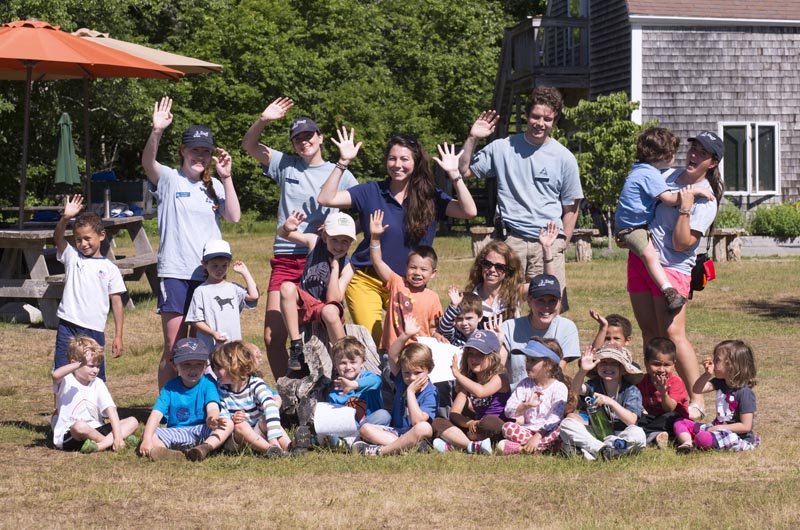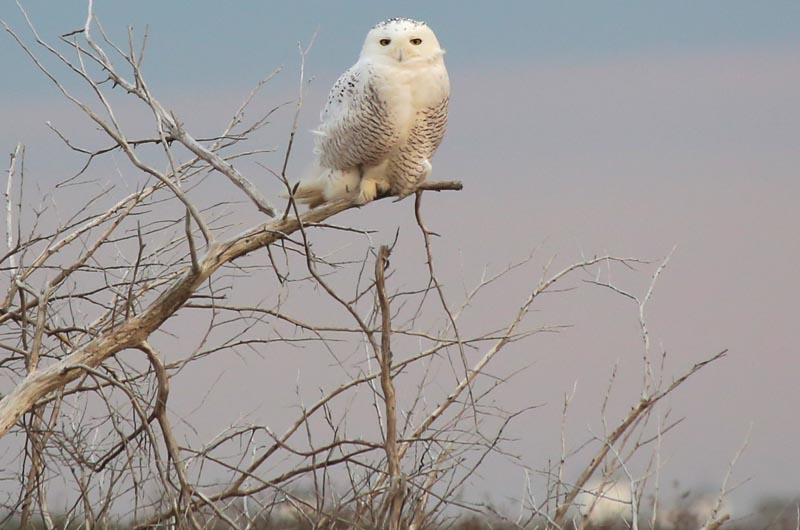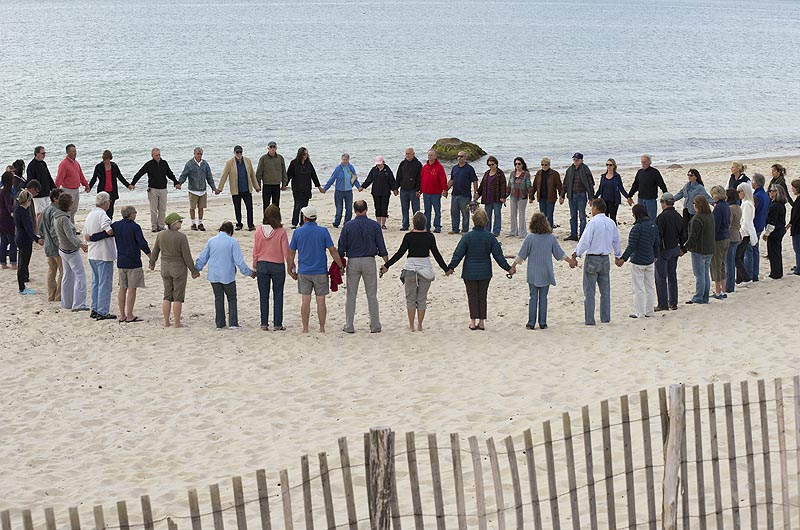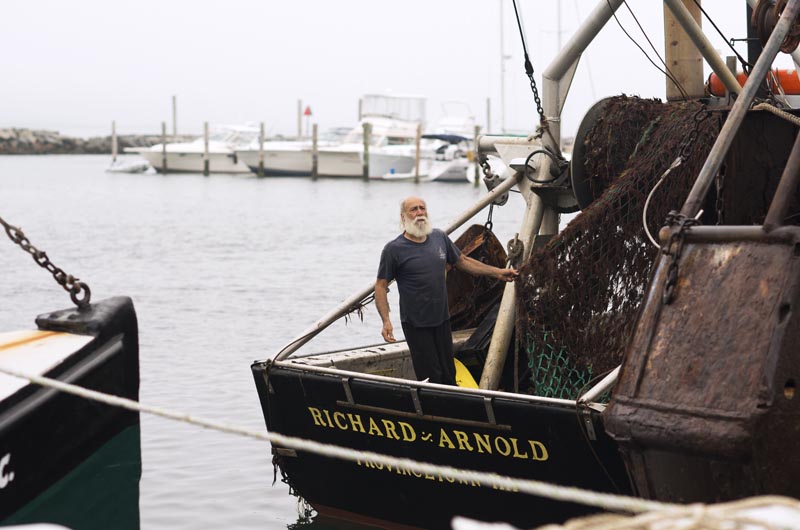It snowed as if it would never stop snowing. Then rain came in buckets and later it became so dry it was as if it might never rain again. Visitors and tourists filled the ferries and a resort economy sputtered back to life. A President came to visit (again). History came alive and sailed down the Sound into Vineyard Haven harbor and Islanders celebrated their heritage with whoops of joy. A cherished member of the community died in an impossible way in a distant place and the Vineyard was left with a hole in its heart.
These are the benchmarks of the year 2014, a year that saw the Vineyard grow a little older and maybe just a little wiser about where it stands in the hurried world that lies seven miles across the Sound. The mainland is not so distant anymore, but the Island way of life remains distinct. People know each other well, sometimes too well. They have many independent governments, sometimes too many, and can be as territorial as the snapping turtles that inhabit the muddy freshwater ponds of the Island. They argue passionately, disagree often and when the going gets rough they lean on each other for strength. They farm the land and the sea, value their children more than jobs and money, care for their elders, cheer for their sports teams, sing, dance and celebrate the arts. They struggle with addiction, isolation and an alarmingly scarce availability of decent housing. And they know that hardiness, resilience and resourcefulness are the best tools for survival on an Island.
But in the winter of 2014, even the hardiest Islanders found themselves challenged by the weather.
When the year began, the ground had already been snow-covered and icy for a month, lashed by bitter winds wailing down from the Canadian Rockies. It was only the beginning of what was to come. Week after week, ferries were cancelled, government offices and schools were shut down as one storm after another hit the Island. By late February the Vineyard had recorded 36 inches of snowfall for the year. Snowplow budgets were already depleted in Island towns.
“We’ve spent it all; it’s been a tough winter,” Oak Bluffs highway superintendent Richard Combra Jr. told the Gazette. Well after it had turned spring by the calendar, winter weather was in the news. “Still Roaring, March Storm Blankets Island,” a front page headline in the Gazette declared on March 28, after another blizzard had swept in. By then, Islanders had stopped counting.
Still spring came, as it always does, followed by the sun-splashed days of early summer and winter weather was a distant memory. Besides, the Island had something new to talk about: The Charles W. Morgan, the last remaining wooden whaleship in the world, had been rebuilt at Mystic Seaport in Connecticut and was preparing to take a historic voyage up the New England coast. One of the Morgan’s stops would be in Vineyard Haven. The old ship had many Vineyard ties in her long history. There was much excitement and anticipation.
“Security, security, barque Charles W. Morgan underway.” These were the captain’s instructions heard over the marine channel on the day the Morgan left her berth at Mystic to be towed down the river to New London and begin her historic 38th voyage. The voyage would take her to Newport, R.I., Vineyard Haven, and then on to New Bedford, Stellwagen Bank, Provincetown and Boston. Trailing behind her were some 2,700 ghost ships from her whaling past. All are gone now save the Morgan. A survivor of fire and other near disasters, she is called the lucky ship.
It was heady stuff and on June 18 the Vineyard gave the Morgan a royal welcome when she sailed into Ralph Packer’s Tisbury Wharf for a stay of several days. There were horns and cannon fire and a cheering crowd to greet the ship, cell phones held aloft to capture the moment in history. Many were in tears.
“I pinch myself. We’re living history and in doing so we’re bringing back history,” said Matthew Stackpole, the ship historian and West Tisbury resident who helped lead the restoration project.
•
If the visit by the Morgan was a high point of the year for the Vineyard, the low point had come one month earlier.
On a Saturday in mid May the Island was stunned to learn that F. Patrick Gregory, the longtime West Tisbury town moderator, Vineyard Haven businessman, soccer coach, father, husband and grandfather had been r obbed and fatally shot while on a hiking expedition in a remote canyon in Northern California. Mr. Gregory’s hiking companion survived, and despite a widespread police manhunt, the assailant was never found.
The news cast a pall across the Island. On May 28 more than 1,000 people poured into the West Tisbury Agricultural Hall for a memorial service for Mr. Gregory. “My dad was a whistler, an optimist, a believer in the human spirit,” son Tim Gregory said in remarks. “We are stunned and speechless and just finding voice for our grief,” said the Rev. Cathlin Baker of the West Tisbury Congregational Church. Her words hung in the air, and all agreed that Pat Gregory had left a legacy of community goodwill.
“Democracy works. That’s the bottom line. It’s pretty inspiring,” he told the Gazette in an interview some years back. How government and democracy function were subjects for debate and scrutiny in 2014.
A plan by Stop & Shop to rebuild its Vineyard Haven store into a much larger facility became a lightning rod for controversy. Review by the Martha’s Vineyard Commission had begun in the summer of 2013 and extended into 2014. The process had many twists and turns and suffered from a lack of transparency. Public criticism was mounting. In early spring, with a public hearing closed and the MVC preparing to vote, Stop & Shop pulled the plan.
The Martha’s Vineyard Airport was in the spotlight amid ongoing struggles between the airport commission and its appointing authority, the Dukes County Commission. Questions of control and authority at the airport have been complicated by intramural lawsuits and a workplace dispute involving a former employee and the airport manager. At year’s end, the problems showed few signs of abating.
In the mid-term elections where a race was on for governor of Massachusetts, some candidates had Island ties. Don Berwick, a longtime Chilmark summer resident, lost his bid for the Democratic party nomination in the September primary. Martha Coakley, a longtime Vineyard visitor, won the primary but lost the election in November to Republican Charlie Baker. In June the man who would become governor visited the Vineyard. “Part of what makes me so passionate about state and local government is that I think it’s a lot closer to the people,” Charlie Baker told the Gazette in an interview.
•
Could the heath hen come back? Stewart Brand and Ryan Phelan think it could and they brought the question to the Island during visits in the spring and later in July for a provocative summer forum. A panel explored the questions and possibilities involving the fields of technology, biology and conservation. Although perhaps lacking the romance of the possible return of an extinct species, the real estate market did begin to stage a small comeback after slumping for several years. It helped propel the Martha’s Vineyard Land Bank back onto the front lines of conservation purchases. In May, the land bank signed a $5.1 million deal to buy a large portion of Tom’s Neck Farm on Chappaquiddick, a rare and unspoiled coastal farmland. A closing is set for January 2015. The long, white winter was visually enhanced by a prolonged visitation from the largest number of snowy owls ever seen on the Vineyard. The arctic owls became a household name as they settled in from December until April, delighting birdwatchers, nature photographers and all who caught a glimpse of the handsome, white-feathered creatures perched along Beach Road between Oak Bluffs and Edgartown, at Katama and Gay Head. It was a good year for other birds, too. Osprey, once endangered, nested here in record numbers.
Summer flew by with ideal weather and long, barefoot beach days, save on the Fourth of July, when the Edgartown parade and fireworks were both postponed for the first time in recent memory thanks to the remnants of Hurricane Arthur. It was the Island’s only brush with a hurricane in 2014. But there were hurricanes to remember — 50 years ago Hurricane Carol and Edna ripped through the Vineyard within two weeks of each other. The Gazette carried rare footage of the two hurricanes on its website through the Historic Movies Project of Martha’s Vineyard.

There were other anniversaries. Felix Neck celebrated 50 years at the Fern and Feather day camp for children. Veterans Memorial Park in Vineyard Haven was rededicated on the occasion of its 50-year anniversary. The Martha’s Vineyard Commission turned 40 and executive director Mark London announced he would retire in 2015. African Americans and others on Martha’s Vineyard took special note of the 50th anniversary of Freedom Summer, a pivotal year in the Civil Rights movement.
The Island had its own role in that movement, especially in Oak Bluffs where African Americans were welcomed long before desegregation and where a large black summer colony has thrived for more than a century. The town will be featured in an upcoming exhibit by the Smithsonian titled Places of Pride, due to open in 2016. In August the Washington, D.C., museum and Martha’s Vineyard Magazine hosted a speaker event at Union Chapel that drew hundreds.
•
By now presidential vacations have become routine in August and Islanders take them in stride. In mid August President Obama and his family arrived for their fifth vacation during his presidency. As in previous years, the Obamas stayed at a rented house in Chilmark, and remained mostly out of sight except for outings with friends and family, and long days on the golf course for the President. But this year more than any other, Mr. Obama was visibly under pressure as world events intruded repeatedly on his vacation.
Summer closed its books on the positive side of the ledger: The Steamship Authority saw a steady uptick in traffic and the Vineyard Transit Authority broke records for ridership. Most businesses reported a good season. Oak Bluffs and Edgartown saw a small surge in new bars and restaurants, including Isola in the space formerly occupied by Lattanzi’s, Bad Martha’s micro-brewery and Beetlebung’s coffee bar by day with a whiskey bar at night.
But for some in business, 2014 was the year to pass the baton or even close the doors. In June, Janet King, who with her family was longtime owner of the Ritz Cafe, sold to new owners. In December Ron and Peggy Jackson confirmed they would sell the Ocean View restaurant to Mike Santoro, an Oak Bluffs businessman and selectman. Beadniks, the popular crafts store that had been a fixture in Vineyard Haven for decades, closed for good as the owner decided to focus on her wholesale and online business.
The Martha’s Vineyard Regional High School hit a rough patch when principal Stephen Nixon resigned abruptly in May after a five-year tenure. By late summer a new principal had been hired; Gilbert Traverso took the helm at the start of the new school year. More leadership change is on the horizon in 2015 as Vineyard schools superintendent Dr. James H. Weiss plans to retire. A search has begun for his replacement.
In sports, the boys’ high school soccer team won the south section division title but found the championship just out of reach. The high school football team ended its season with five straight wins, including taking Nantucket by storm in the storied annual Island Cup rivalry. In June, World Cup fever gripped the Vineyard Brazilian community. In its fourth summer, the Sharks’ collegiate baseball team had plenty of fans turn out for games under the lights, but apparently not enough — after the season had ended there was a management shake-up, as owners sought to rein in costs.
The summer arts scene thrived. The Vineyard Playhouse opened the doors on a new season in a freshly rebuilt playhouse on Church street in Vineyard Haven. Rosanne Cash played a sold-out concert at Flatbread in a benefit for the relocation of the Gay Head Light. The Yard and Vineyard Arts Project continued to hold their place as the Vineyard’s Jacob’s Pillow.
And as it sometimes is, the Island was a stage for world issues. A key breakthrough in Alzheimer’s research funded by two Vineyard residents was unveiled at a Hebrew Center lecture in July.
The year had its darker side, too. Community leaders in law enforcement and social services began to register concern and alarm over evidence that heroin addiction, now epidemic in Massachusetts, is a growing problem here. In February, nine fatal overdoses had been reported on the Cape and Islands. Meanwhile, teen stress and risky coping mechanisms were documented in a study by the youth task force.
The Island again mourned the loss of some of its cherished citizens, both summer and winter: John Varkonda, longtime superintendent of the Manuel F. Correllus State Forest; Louis Larsen, scion of a Vineyard fishing family; Ethel Sherman, staple of the West Tisbury Farmers’ Market; Carl Widdiss, Gay Head Wampanoag; Robert Potts, publisher of the Broadside; Luciano Rebay, Italian poet and academic; Mike Nichols, Hollywood director; Norman Bridwell, author, illustrator and creator of Clifford the Big Red Dog.
On the waterfront, oyster farmers embraced new practices to reduce incidents of illness from the bacteria Vibrio. The worrisome ongoing decline of the offshore fisheries brought new rules for striped bass, cod and conch. The 68th derby ran for a month and sport fishermen aged eight to 80 staged a cheerful Island takeover, from boat and shore. The fall bay scalloping season opened with a strong fishery in Edgartown and no fishery at all in Aquinnah, creating an economic pinch for those who rely on shellfishing to put food on the table.
The Gay Head Light remained perched precariously at the edge, as plans progressed for a $3 million project to move it back from an eroding cliff in 2015.
Just before Thanksgiving, a historic Pagoda tree in Edgartown was saved from an early demise. Homeowners on South Water street had a change of heart over their plan to build a three-car garage atop the roots of the tree that was brought to Edgartown by a sea captain in a flowerpot 1837. Instead they will build a one-car garage. Can a tree smile? If so, it did.
Then it was December and the Vineyard twinkled with lights from Chappaquiddick to Aquinnah. Down in Menemsha, Everett Poole fashioned a Christmas tower from lobster pots with a star on top. And as Islanders paused to reflect on the year just past and looked ahead to 2015, at least one thing was distinctly different. Not a snowflake in sight. Not yet.













Comments
Comment policy »